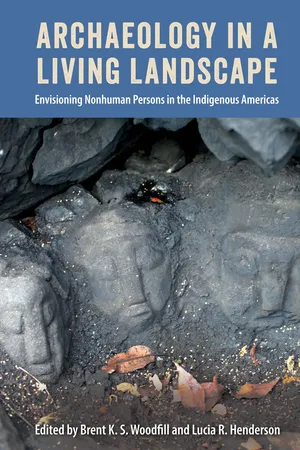
Archaeology in a Living Landscape
Envisioning Nonhuman Persons in the Indigenous Americas
- English
- ePUB (mobile friendly)
- Available on iOS & Android
Archaeology in a Living Landscape
Envisioning Nonhuman Persons in the Indigenous Americas
About this book
Recognizing and incorporating Indigenous knowledge systems in archaeological studies of the Americas
This book explores the diverse range of other-than-human persons that inhabited and affected the landscape of the ancient Americas. These case studies acknowledge what is often dismissed by Western scholars: that Indigenous communities have long recognized degrees of personhood in mountains, volcanoes, caves, springs, rivers, rocks, plants, archaeological sites, trees, and animals and that this worldview should be taken seriously in archaeological investigations, community relations, and interpretations.
In Archaeology in a Living Landscape, contributors examine the role of nonhuman agents in the ancient world, from land management and tenure to economics, politics, migration, pilgrimage, trade routes, conquest, ethics, and philosophy. Chapters describe Tlingit cosmology, lightning beings and magnetism in the Minnesota River Region, linguistic approaches to animacy in the United States Southeast, nonhuman persons in the ancient Maya economy, and Lacandon Maya ritual landscapes. They investigate the role of quarries in the building of Inka huacas (sacred spaces or objects), clay procurement and Andean apus (powerful mountains), Amazonian animism in polychrome ceramics, and the built and unbuilt landscape of the Mapuche. An epilogue by Dakota elder James Rock highlights how Western academic discourse often diverges from the viewpoints of Indigenous subjects.
The contributors to this volume use
language accessible to readers of diverse backgrounds. They focus on the
centrality of nonhuman persons in the lives of Indigenous communities,
working to move away from Western biases to embrace and integrate
Indigenous belief frameworks in their studies. Archaeology in a Living Landscape highlights the value of Indigenous knowledge systems not just as archaeological evidence but as a body of theory.
Contributors: Steve J. Langdon | Lisa J. Lucero | Alexei Vranich | James Rock | Eleanor Harrison-Buck | Lucia R. Henderson | Nicola Sharratt | Patrick Ryan Williams | Bill Sillar | Brent K.S. Woodfill | Jacob J. Sauer | Margaret Spivey-Faulkner | Sigrid Arnott | Dianne Desrosiers | Joshua Feinberg | David Maki | Carolyn Dean | Alice Balsanelli | Joel W. Palka | A.C. Roosevelt | Dennis Ogburn
Frequently asked questions
- Essential is ideal for learners and professionals who enjoy exploring a wide range of subjects. Access the Essential Library with 800,000+ trusted titles and best-sellers across business, personal growth, and the humanities. Includes unlimited reading time and Standard Read Aloud voice.
- Complete: Perfect for advanced learners and researchers needing full, unrestricted access. Unlock 1.4M+ books across hundreds of subjects, including academic and specialized titles. The Complete Plan also includes advanced features like Premium Read Aloud and Research Assistant.
Please note we cannot support devices running on iOS 13 and Android 7 or earlier. Learn more about using the app.
Information
Table of contents
- Cover
- Title Page
- Copyright Page
- Contents
- List of Figures
- List of Tables
- Preface
- 1. “Peopling” the Americas: Animate Landscapes and the Archaeology of the Western Hemisphere
- Part I. North and Central America
- Part II. South America
- List of Contributors
- Index